Carlo Scarpa’s Brion-Vega Cemetery in Italy
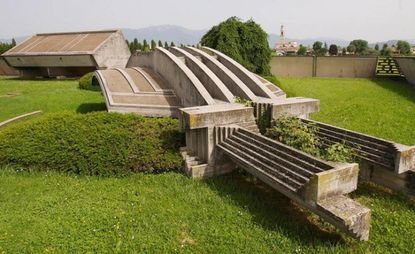
One of Carlo Scarpa's most iconic and seminal built works (and a project so close to his heart that a space in it was saved for his own use) was the Brion family cemetery.
Scarpa (1906-1978) designed the Brion-Vega in San Vito d'Altivole, near Italy's Treviso, as an extension to the family's existing cemetery. The architect developed the geometrical concrete composition over a 10-year period, with works finally reaching completion in 1978.
The L-shaped plot includes a complex of five buildings; a small chapel, the entrance hall, a small steel-and-wood pavilion on an island in the site's water pond, the main tomb, and an open-air structure covering the graves.

Behind the scenes for W*114, August 2008
Aiming to create a poetic resting place as much as a sculptural memorial in a green, calming garden, Scarpa used well-thought-out design features; for example, the cemetery walls are not higher than the surrounding field's plants, discreetly merging the structure into the landscape.
Within the site, there is also a small island with no apparent access for visitors, which perhaps works as a metaphor for the afterlife.
The architect himself rests, vertically, in the cemetery walls, after passing away in 1978 during a trip to Japan – the same year that his last masterpiece was finished.
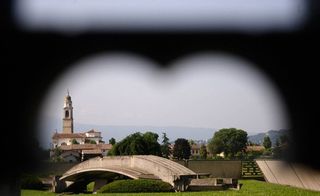
Carlo Scarpa’s Brion-Vega cemetery, San Vito d’Altivole, Italy
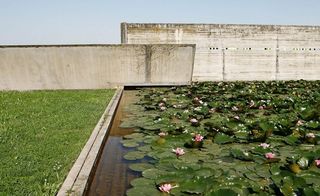
Scarpa also designed a pond for the L-shaped site

The open-air structure that covers the graves

Reflection of the main tomb in the cemetery’s pond

Detail of the geometric concrete masonry

Detail of the geometric concrete masonry
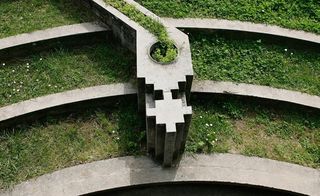
Detail of the geometric concrete masonry
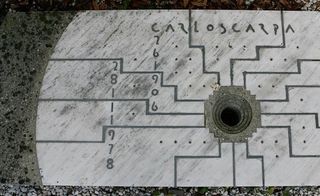
The architect himself is buried within his masterpiece
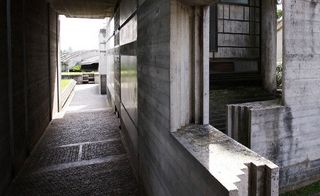
The main tomb
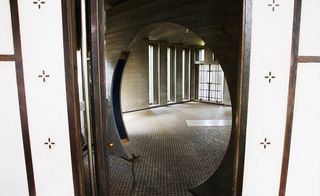
Inside the small chapel
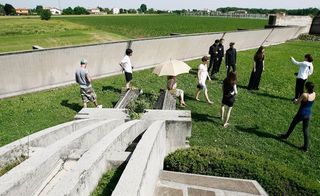
Behind the scenes of our W*114 fashion shoot in Scarpa’s Brion-Vega cemetery


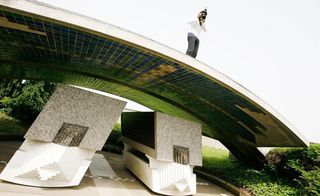

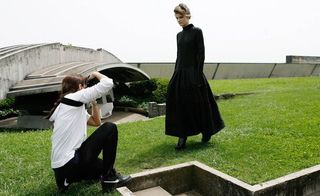

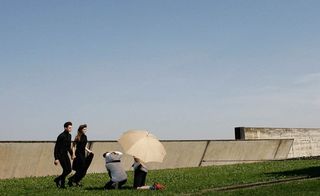
Wallpaper* Newsletter
Receive our daily digest of inspiration, escapism and design stories from around the world direct to your inbox
Ellie Stathaki is the Architecture & Environment Director at Wallpaper*. She trained as an architect at the Aristotle University of Thessaloniki in Greece and studied architectural history at the Bartlett in London. Now an established journalist, she has been a member of the Wallpaper* team since 2006, visiting buildings across the globe and interviewing leading architects such as Tadao Ando and Rem Koolhaas. Ellie has also taken part in judging panels, moderated events, curated shows and contributed in books, such as The Contemporary House (Thames & Hudson, 2018), Glenn Sestig Architecture Diary (2020) and House London (2022).
-
 Objects Are By unite creatives with artisans to create a new world of product design
Objects Are By unite creatives with artisans to create a new world of product designMilan-based brand Studio Objects Are By is introducing a novel idea to the design process. They're asking: What if you let an artist, an actor or a chef moonlight as a product designer?
By Laura May Todd Published
-
 Barbie and Kartell’s pink chairs are fit for dreamhouses large and small
Barbie and Kartell’s pink chairs are fit for dreamhouses large and smallBarbie x Kartell is a series of pink chairs, toy-sized and adult-sized, debuting at Milan Design Week 2024 in collaboration with Mattel Creations
By Tianna Williams Published
-
 Inside Valentino’s glamorous new Sloane Street store, inspired by the art of haute couture
Inside Valentino’s glamorous new Sloane Street store, inspired by the art of haute coutureThe latest in Valentino’s ‘The New Maison’ store concept opens on London’s Sloane Street this week, offering an enveloping marble and carpet-clad space of ‘intimacy and uniqueness’
By Jack Moss Published
-
 Giovanni Michelucci’s dramatic concrete church in the Italian Dolomites
Giovanni Michelucci’s dramatic concrete church in the Italian DolomitesGiovanni Michelucci’s concrete Church of Santa Maria Immacolata in the Italian Dolomites is a reverently uplifting memorial to the victims of a local disaster
By Jonathan Glancey Published
-
 Milan’s 10 Corso Como revamp nods to the concept store’s industrial character
Milan’s 10 Corso Como revamp nods to the concept store’s industrial characterMilanese concept store 10 Corso Como unveils its new look by 2050+, a stripped-back design that nods to its 20th-century character
By Ellie Stathaki Published
-
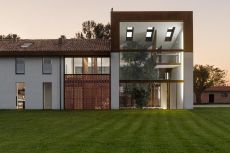 Carlo Ratti announced curator of Venice Architecture Biennale 2025
Carlo Ratti announced curator of Venice Architecture Biennale 2025Carlo Ratti has been revealed as the Director of the Architecture Department at the Venice Architecture Biennale 2025, with the specific task of curating the 19th International Architecture Exhibition
By Ellie Stathaki Published
-
 Floating infinity pool by Herzog & De Meuron at Lake Como is largest of its kind
Floating infinity pool by Herzog & De Meuron at Lake Como is largest of its kindHerzog & de Meuron creates the largest floating infinity pool in the world for Mandarin Oriental in Lake Como
By Lauren Ho Published
-
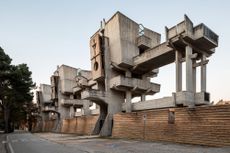 Best of brutalist Italian architecture chronicled in new book
Best of brutalist Italian architecture chronicled in new bookBrutalist Italian architecture enthusiasts and concrete completists will be spoilt for choice by Roberto Conte and Stefano Perego’s pictorial tour
By Jonathan Bell Published
-
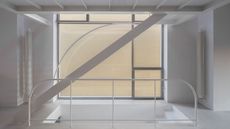 Studio Tropicana, Switzerland and Italy: Wallpaper* Architects’ Directory 2023
Studio Tropicana, Switzerland and Italy: Wallpaper* Architects’ Directory 2023Based in Switzerland and Italy, Studio Tropicana is part of the Wallpaper* Architects’ Directory 2023, our annual round-up of exciting emerging architecture studios
By Ellie Stathaki Published
-
 WeWork Meravigli blends past and present in a 21st-century office space
WeWork Meravigli blends past and present in a 21st-century office spaceWeWork Meravigli launches in Milan, bringing its ornate, historical new home to the 21st century
By Ellie Stathaki Published
-
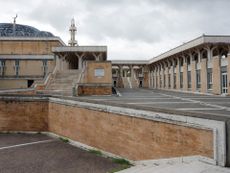 In memoriam: Paolo Portoghesi (1931 - 2023)
In memoriam: Paolo Portoghesi (1931 - 2023)Postmodernist Italian architect Paolo Portoghesi has died; writer David Plaisant celebrates his life and legacy, recalling his visit to Calcata for a feature in the Wallpaper* April 2021 issue
By David Plaisant Published